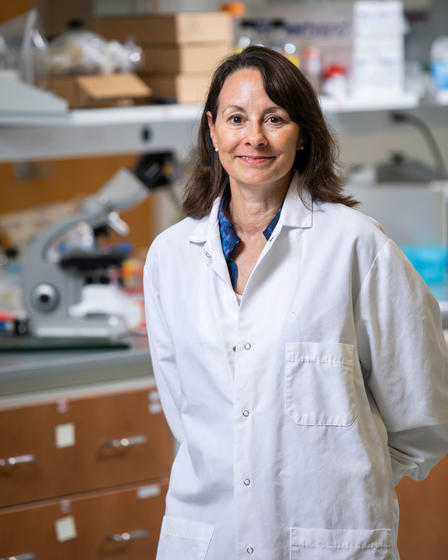In This Story
Joint pain is a common nuisance for many Americans and is especially prevalent in an aging population. Bioengineering Professor Caroline Hoemann from George Mason University is leading an effort to discover how our bodies can manage that problem. Some of her team’s findings were published in the interdisciplinary science journal PLOS ONE in September.

Photo by Ron Aira in Creative Services at George Mason University
Healthy joints move with a smooth and nearly frictionless glide thanks to the presence of a sugar polymer called hyaluronic acid (HA). Scientists think high HA production is beneficial because HA helps reduce friction between cartilage surfaces. They also believed that an enzyme called UDP-glucose 6-dehydrogenase (UGDH) could control how much HA the synovium (a soft tissue in our joints) makes. Until recently, however, it was impossible to know if the enzyme activity was dialed up or down by the factors that our bodies release after a joint injury.
Hoemann and her team developed a new technique to accurately observe UGDH activity under a microscope and made several discoveries. After exposing synovial cells to cytokines – small proteins important for cell signaling, and ones that are known to be released after joint injury – they froze the thin sheet of cells to –80 degrees Celsius.
When they stained the thawed cells the researchers discovered that active enzymes turn cells purple, but low activity produced only a faint color. They also learned that platelet-derived growth factor, a substance that can stimulate cell production and healing, released from blood cells after joint injury, could stimulate UGDH activity and HA release. They further observed that when they exposed cells to oxidizing inflammatory factors, HA production rose even higher, but without the typical corresponding increase in UGDH activity.
These findings suggest that UGDH activity levels don't necessarily match the amount of HA released into the joint fluid and that platelet-derived growth factors could be used to stimulate the body's cells to make more HA. In the same study, Associate Professor from the College of Science, Mikell Paige, and Research Assistant Professor, Suman Alishetty, helped identify that the purple stain involved a second anti-oxidant enzyme activity that could help sustain UGDH activity. Both UGDH and this second enzyme became activated in the synovium one week after cartilage repair surgery.
These findings indicate that in the first few weeks after joint surgery, mild synovial inflammation and higher UGDH activity could be considered a positive sign that the synovium is working to help joint tissues heal. Results from the study could also influence future cancer research. Hoemann and her team observed that lung cancer cells had very high UGDH activity, which is linked in other studies to cancer cell migration, worsening the disease. They also observed that peroxide, an oxidant, inhibits UGDH, which could suggest that anti-oxidants can promote certain cancers to metastasize by keeping the UGDH enzyme active.
